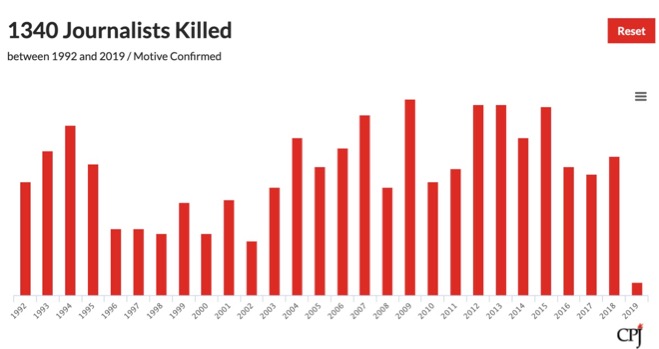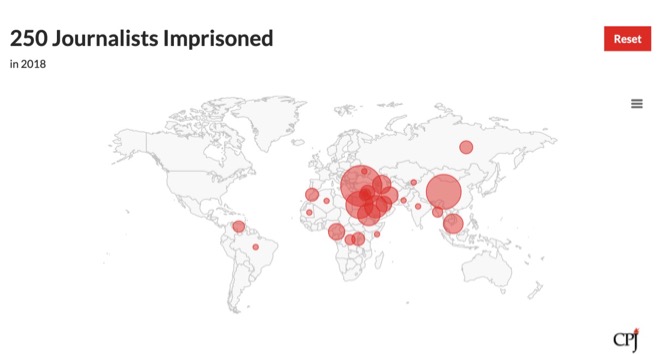World Press Freedom Day Is a Reminder of the Dangers Faced by Honest Journalists

Marking this year’s United Nations World Press Freedom Day on May 3—I represented the IARJ on State of Belief, a global radio-and-internet broadcast, to talk with host Welton Gaddy about the importance of journalists working together around the world.
LISTEN TO THE STATE OF BELIEF INTERVIEW: Here is a link to listen to the entire interview featuring Welton Gaddy and the IARJ’s David Crumm.
In addition to encouraging the best in journalistic practices by sharing our wisdom peer to peer, the IARJ also shares online resources and hosts conferences around the world to help religion journalists meet their colleagues in other countries and promote the overall wellbeing of our profession.
Already in 2019, however, the latest data from The Committee to Protect Journalists (CPJ) shows the dangers honest journalists may encounter. Worldwide, hundreds of journalists remain imprisoned and, already this year, at least five have been killed for their work. Of course, CPJ data counts all journalists reporting in all formats, covering all subjects. CPJ does not specifically track religion journalists as a specialty.
However, the IARJ’s leadership is continually hearing reports of religion journalists who are concerned about perilous conditions around the world. The IARJ’s global conference this autumn will be held in the United States and will include peer-to-peer sessions discussing the dangers and challenges of reporting on religious issues that may spark extreme reactions.
Some Good News for Religion Journalists
- FREEDOM FOR MYANMAR REPORTERS—Journalists around the world are celebrating the release of Myanmar-based Reuters journalists Wa Lone and Kyaw Soe Oo after more than a year in custody. These two colleagues were caught up in a government effort to intimidate all journalists who dared to cover the ethnic cleansing of Myanmar’s Muslim minority, the Rohingya. Just before their release, pressure mounted on government officials as the men were awarded the Pulitzer Prize for International Reporting for documenting an infamous case of mass murder. While these reporters do not describe themselves specifically as
religion journalists,
this story clearly involves religious conflict. - LILLY ENDOWMENT GRANT FOR GLOBAL REPORTING—After years of cut backs in newsrooms around the world, fresh resources are focusing on religion reporting. A week ago, the U.S.-based Lilly Endowment announced a $4.9-million grant to three media organizations—the Religion News Service, the Associated Press and The Conversation—to increase reporting on the importance of religion around the world. (Here is the AP version of that announcement.)
- REGIONAL EFFORTS—Here in Michigan where I am based, as a part of the IARJ, the Cynthia and Edsel Ford Fund for Journalism has just announced $200,000 over five years to expand Detroit Public TV reporting. That means Detroit-based public-television reporters will expand the number of stories going into regular series such as One Detroit, American Black Journal and PBS NewsHour. Those stories will cover a wide range of subjects, but Detroit is well known as an international center of religious diversity, so some of those stories will explore religion. (Here is the short YouTube clip of this announcement by DPTV.)
- THE IARJ’s PARTNERSHIP IN A NEW CONTEST—In March, we announced that the IARJ and the Fondazione per le Scienze Religiose Giovanni XXIII (FSCIRE), an Italian research institute focused on religious studies, have joined forces to launch a new award for religion reporting, the Piazza Grande Religion Journalism Award. This award will encourage the best in religion reporting specifically in Europe and the Mediterranean basin. Here is our announcement of the award—and, please, stay tuned to our website for an announcement this spring of full contest details.
Resources for the Protection of Religion Journalists
The IARJ’s mission is providing services and resources to strengthen and support the work of its members.
That includes engaging media leaders, educational institutions and communities on the importance of accurate, balanced, and ethical religion coverage to foster understanding.
The following are some of the world’s most important resources for protecting the safety of journalists who are facing dangerous conditions as they report on especially sensitive subjects. The first three groups listed here were involved in building worldwide pressure to force the freeing of the two Myanmar journalists.
NOTE: Journalists watching threats to media should compare data from these groups. For example, Reporters without Borders already is listing 10 journalists killed in 2019, which is higher than the 5 cases CPJ has documented so far.
- THE COMMITTEE TO PROTECT JOURNALISTS—The U.S.-based, global organization is sometimes called Journalism’s Red Cross for its boundary-crossing efforts to assist endangered reporters. Here is the Wikipedia overview of the organization. And, here is CPJ’s homepage.
- REPORTERS WITHOUT BORDERS—Based in Paris, RWB is also known as Reporters Sans Frontières (RSF). Founded in 1985, this group collaborates with CPJ and other worldwide organizations, but has a more specific focus on monitoring threats to media in general. Here is the Wikipedia overview, and here is RWB’s homepage. NOTE: RWB provides many helpful resources for journalists in dangerous corners of the world, including specialized publications and a very helpful Online Survival Kit. RWB will even loan bullet-proof vests and other protective gear to reporters from a stock at the group’s Paris headquarters.
- PEN AMERICA—This century-old, U.S.-based organization casts an even broader net for writers and editors both in North America and around the world. Its members also include novelists, screenwriters and poets as well as journalists. Given the long history and famous names of its members, PEN America has been helpful in many global efforts, including putting pressure on the Myanmar government recently. Here is the Wikipedia overview, and here is PEN America’s website.
- WORLD PRESS FREEDOM DAY—This UN-sponsored annual observance marks the day in 1991 when African journalists meeting in Namibia issued the Windhoek Declaration. This was an influential, pioneering declaration that led to further public proclamations in Asia, the Middle East and Latin America. In 2019, the 26th celebration of World Press Freedom Day was jointly organized by UNESCO, the African Union Commission and the Government of the Federal Democratic Republic of Ethiopia. The main event took place in Addis Ababa at the African Union Headquarters under the theme
Media for Democracy: Journalism and Elections in Times of Disinformation.
FINALLY, here is 1 more chart from The Committee to Protect Journalists:

